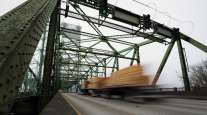New Ambassador Bridge to Dedicate One Lane for Pre-Screened Trucks

The new span of the Ambassador Bridge, which the Detroit International Bridge Co. recently obtained a permit to build, will include a lane dedicated to pre-approved trucks moving across the border, according to Dan Stamper, president of the company.
The permit, announced Sept. 6, allows the company to build a second span for the Ambassador Bridge, which stretches across the Detroit River and links Detroit to Windsor, Ontario.
Some 1,495,716 trucks have crossed the Ambassador Bridge since January, according to the Public Border Operators Association.
The new span will broaden the existing Ambassador Bridge by offering six lanes, three going in each direction. The current bridge has four lanes, two in each direction. Stamper said trucks pre-screened through U.S. Customs and Border Protection’s Free and Secure Trade program will have a lane to themselves.
“The reason we’re going to six lanes is to have a lane dedicated to the FAST trucks,” Stamper said. “Our goal has always been to expedite the commercial traffic and the commuter traffic.”
The FAST program is a commercial clearance program for known low-risk shipments entering the United States from Canada and Mexico. It was initiated after the terror attacks of Sept. 11.
FAST lanes will help funnel traffic through the proper customs gateway, according to Public Border Operators Association President Ron Rienas. He said that congestion on international bridges usually occurs because of customs, which stall due to lack of staff or computer crashes, rather than a high number of vehicles. He also said that most of the trucks moving along this corridor are transporting automotive-related goods.
The Ambassador Bridge was the longest suspension bridge in North America when it opened in 1929, according to Detroit International Bridge Co. The new bridge will consist of a 2,190-foot cable-stayed main span. The existing bridge will be decommissioned.
According to Rienas, the congestion that occurs on an interstate bridge is amplified on an international bridge because drivers have to talk with customs officials rather than throw 50 cents into a basket and continue driving.
“The congestion is not the result of bridge lane capacity at all. It’s customs at either end. Customs take time. That’s just their nature,” Rienas said. “The benefit of doing [FAST lanes] is not for volume. It’s to stream traffic so that one lane in each direction can be dedicated to vehicles that are part of a customs program.”
The bridge company has several governmental hurdles to clear before it can start work. Michigan Gov. Rick Snyder released a statement Sept. 6 expressing optimism and caution: “Construction on a replacement span would not begin unless and until further governmental approvals in the U.S. are obtained and several conditions established by Canada are met,” he said.
Canada’s International Bridges and Tunnels Act states those conditions include “the dismantling of the existing bridge when the replacement bridge is open, improving local infrastructure, creating new public green spaces, and protecting the environment and considering indigenous interests.”
According to Michigan Department of Transportation, approvals from the state’s departments of Natural Resources, Interior and Environmental Quality, as well as a tall-structures permit from MDOT, are needed before construction can begin.
Despite these outstanding approvals, Stamper said he hopes construction will begin late this year or early next year.
“If he can do that, then that would be pretty impressive,” said William Anderson, director of the University of Windsor’s Cross-Border Institute. “It’s very ambitious.”
Anderson, who has a view of the Ambassador Bridge from his office, said it has a FAST lane plaza but no designated lane for these pre-approved vehicles.
The Ambassador Bridge is not the only project underway to link Detroit to Windsor. The Windsor-Detroit Bridge Authority, which is owned by the Canadian government, is working to erect the Gordie Howe International Bridge. This span would be about 2 miles downstream from the Ambassador Bridge. According to Anderson, work on the Gordie Howe Bridge likely will begin in the next five or six years.
The expanded Ambassador Bridge and the Gordie Howe Bridge will join the Detroit-Windsor tunnel, which opened in 1930 and has seen 24,786 trucks move through it this year, according to Public Border Operators Association. Anderson said most trucks are too tall to travel through the tunnel, although certain vehicles, such as car carriers with no cars loaded onto them, can clear its mouth.
“It’s not big enough for full-size trucks. Virtually all of the trucks that go through this corridor go across the Ambassador Bridge,” Anderson said. “If you can fit in the tunnel, you can go.”




